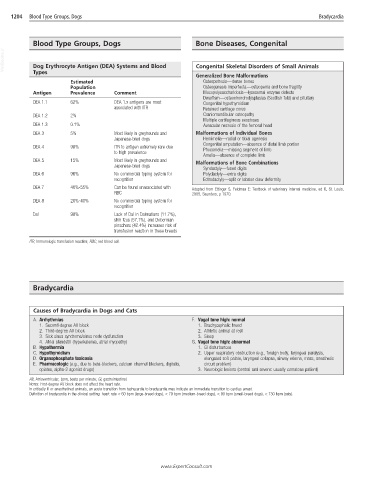Page 2432 - Cote clinical veterinary advisor dogs and cats 4th
P. 2432
1204 Blood Type Groups, Dogs Bradycardia
Blood Type Groups, Dogs Bone Diseases, Congenital
VetBooks.ir Dog Erythrocyte Antigen (DEA) Systems and Blood Congenital Skeletal Disorders of Small Animals
Types
Generalized Bone Malformations
Estimated Osteopetrosis—dense bones
Population Osteogenesis imperfecta—osteopenia and bone fragility
Antigen Prevalence Comment Mucopolysaccharidosis—lysosomal enzyme defects
Dwarfism—osteochondrodysplasias (Scottish fold) and pituitary
DEA 1.1 62% DEA 1.x antigens are most Congenital hypothyroidism
associated with ITR Retained cartilage cores
DEA 1.2 2% Craniomandibular osteopathy
Multiple cartilaginous exostoses
DEA 1.3 0.1% Avascular necrosis of the femoral head
DEA 3 5% Most likely in greyhounds and Malformations of Individual Bones
Japanese-bred dogs Hemimelia—radial or tibial agenesis
Congenital amputation—absence of distal limb portion
DEA 4 98% ITR to antigen extremely rare due Phocomelia—missing segment of limb
to high prevalence
Amelia—absence of complete limb
DEA 5 15% Most likely in greyhounds and Malformations of Bone Combinations
Japanese-bred dogs
Syndactyly—fused digits
DEA 6 96% No commercial typing system for Polydactyly—extra digits
recognition Ectrodactyly—split or lobster claw deformity
DEA 7 40%-55% Can be found unassociated with Adapted from Ettinger S, Feldman E: Textbook of veterinary internal medicine, ed 6, St. Louis,
RBC 2005, Saunders, p 1970.
DEA 8 20%-40% No commercial typing system for
recognition
Dal 98% Lack of Dal in Dalmatians (11.7%),
shih tzus (57.1%), and Doberman
pinschers (42.4%) increases risk of
transfusion reaction in these breeds
ITR, Immunologic transfusion reaction; RBC, red blood cell.
Bradycardia
Causes of Bradycardia in Dogs and Cats
A. Arrhythmias F. Vagal tone high: normal
1. Second-degree AV block 1. Brachycephalic breed
2. Third-degree AV block 2. Athletic animal at rest
3. Sick sinus syndrome/sinus node dysfunction 3. Sleep
4. Atrial standstill (hyperkalemia, atrial myopathy) G. Vagal tone high: abnormal
B. Hypothermia 1. GI disturbances
C. Hypothyroidism 2. Upper respiratory obstruction (e.g., foreign body, laryngeal paralysis,
D. Organophosphate toxicosis elongated soft palate, laryngeal collapse, airway edema, mass, anesthetic
E. Pharmacologic (e.g., due to beta-blockers, calcium channel blockers, digitalis, circuit problem)
opiates, alpha-2 agonist drugs) 3. Neurologic lesions (central and severe: usually comatose patient)
AV, Atrioventricular; bpm, beats per minute; GI, gastrointestinal.
NOTES: First-degree AV block does not affect the heart rate.
In critically ill or anesthetized animals, an acute transition from tachycardia to bradycardia may indicate an immediate transition to cardiac arrest.
Definition of bradycardia in the clinical setting: heart rate < 60 bpm (large-breed dogs), < 70 bpm (medium-breed dogs), < 90 bpm (small-breed dogs), < 130 bpm (cats).
www.ExpertConsult.com

